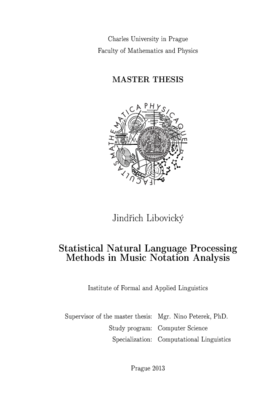Statistical Natural Language Processing Methods in Music Notation Analysis
Statistical Natural Language Processing Methods in Music Notation Analysis
diplomová práce (OBHÁJENO)

Zobrazit/
Trvalý odkaz
http://hdl.handle.net/20.500.11956/55332Identifikátory
SIS: 112318
Katalog UK: 990015894340106986
Kolekce
- Kvalifikační práce [11978]
Autor
Vedoucí práce
Oponent práce
Mareček, David
Fakulta / součást
Matematicko-fyzikální fakulta
Obor
Matematická lingvistika
Katedra / ústav / klinika
Ústav formální a aplikované lingvistiky
Datum obhajoby
20. 5. 2013
Nakladatel
Univerzita Karlova, Matematicko-fyzikální fakultaJazyk
Angličtina
Známka
Výborně
Klíčová slova (anglicky)
statistical melody modeling, music notation, NLP methods, audio melody extractionPráce shrnuje dosavadní výzkum v oblasti aplikace statistických metod počítačové lingvis- tiky při zpracování hudby a vysvětluje teoretické pozadí těchto aplikací. V druhé části práce jsou shrnuty možnosti symbolické extrakce melodie. Byl vytvořen korpus přibližně 400 hodin melodií různých hudebních stylů, který je využit pro trénování statistického modelu melodie založeného na metodách jazykového modelování. V třetí části práce je tento model využit k pokusu vytvořit alternativní metodu extrakce melodie ze zvukového záznamu, která místo běžně používaných heuristik a pravidel využívá model melodie. Systém funguje dobře pouze na jednoduchých vstupních datech, ale na standardních datech ze soutěže MIREX nedosa- huje úspěšnosti v současnosti existujících systému. Provedené experimenty s rozpoznáváním melodie pomohly lépe definovat rozdíl mezi tím, jak vypadá průběh frekvence vnímané jako melodie - fyzikální melodie, a jak je melodie vnímána na abstraktní úrovni při symbolickém zápisu - abstraktní melodie. 1
The thesis summarizes the research in application of statistical methods of computational linguistics in music processing and explains theoretical background of these applications. In the second part methods of symbolic melody extraction are explored. A corpus of approxi- mately 400 hours of melodies of different music styles was created. A melody model using the language modeling techniques was trained on this corpus. In the third part of the thesis the model is used for an attempt to develop an alternative method of audio melody extraction which uses the melody model instead of commonly used heuristics and rules. The chosen ap- proach works well only on simple input data and produces worse results than the commonly used methods on the MIREX contest data. On the other hand, the experiments help to understand the conceptual between the pitch frequency development - the physical melody - and the melody perceived on an abstract level in the symbolic notation - the symbolic melody. 1
